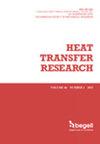用于增强空气通道热性能的圆柱形横杆
IF 1.6
4区 工程技术
Q3 THERMODYNAMICS
引用次数: 0
摘要
在一个矩形通道中,采用八个不同的圆柱横杆阵列作为插入物,进行了传热和压降实验。此外,还进行了数值模拟,以检查圆柱造成的二次流。目的是研究局部流动、圆柱阵列几何形状和流动雷诺数对通道壁传热和压降的影响。采用了 1.0 毫米和 2.0 毫米两种不同直径的圆柱体。直径为 2.0 毫米的圆柱体用于创建四个直列阵列,而直径为 1.0 毫米的圆柱体用于创建四个交错阵列。圆筒阵列采用不同的直径间距比(0.025 至 0.2)和圆筒相对于主流动方向的方向(45°、90°)。流动雷诺数在 600 到 13000 之间变化。在数值研究中,只模拟了两种阵列几何形状,一种是直列式,另一种是交错式,圆筒与流动方向成 90°。数值结果表明,局部流动在圆筒和通道壁之间的间隙中加速。圆柱体下游的涡流脱落与通道壁相互作用。在有和没有圆柱体的情况下,测量了通道壁上的努塞尔特数和摩擦因数。当雷诺数小于 3000 时,努塞尔特数和摩擦因数的比率随雷诺数的增加而增加。这些比率始终随直径与间距比的增大而增大。本文章由计算机程序翻译,如有差异,请以英文原文为准。
Cylindrical Cross-Bars for Thermal Performance Augmentation in Air Channel
Experiments of the heat transfer and pressure drop are performed in a rectangular channel employing eight different arrays of cylindrical cross-bars as inserts. Numerical simulations are also performed to examine the secondary flow caused by the cylinders. The objectives are to investigate the enhancement of the channel-wall heat transfer and pressure drop caused by the local flow, cylinder array geometry, and flow Reynolds number. Two different cylinder diameters of 1.0 mm and 2.0 mm are employed. The diameter of 2.0 mm is used to create four in-line arrays while the diameter of 1.0 mm is used to create four staggered arrays of the cylinders. The cylinder arrays employ different diameter-to-pitch ratios (0.025 to 0.2) and cylinder orientations (45°, 90°) relative to the main flow direction. The flow Reynolds number is varied between 600 and 13000. Only two array geometries, one in-line and one staggered, with the cylinders oriented at 90° to the flow are modelled for the numerical study. The numerical results show the local flow accelerates in the gap between the cylinder and channel wall. The vortex shedding downstream of the cylinders interacts with the channel wall. The Nusselt number on the channel wall and friction factor are measured with and without the cylinders. The ratios of Nusselt numbers and friction factors increase with the Reynolds number when the Reynolds number is less than 3000. The ratios always increase with the diameter-to-pitch ratio.
求助全文
通过发布文献求助,成功后即可免费获取论文全文。
去求助
来源期刊

Heat Transfer Research
工程技术-热力学
CiteScore
3.10
自引率
23.50%
发文量
102
审稿时长
13.2 months
期刊介绍:
Heat Transfer Research (ISSN1064-2285) presents archived theoretical, applied, and experimental papers selected globally. Selected papers from technical conference proceedings and academic laboratory reports are also published. Papers are selected and reviewed by a group of expert associate editors, guided by a distinguished advisory board, and represent the best of current work in the field. Heat Transfer Research is published under an exclusive license to Begell House, Inc., in full compliance with the International Copyright Convention. Subjects covered in Heat Transfer Research encompass the entire field of heat transfer and relevant areas of fluid dynamics, including conduction, convection and radiation, phase change phenomena including boiling and solidification, heat exchanger design and testing, heat transfer in nuclear reactors, mass transfer, geothermal heat recovery, multi-scale heat transfer, heat and mass transfer in alternative energy systems, and thermophysical properties of materials.
 求助内容:
求助内容: 应助结果提醒方式:
应助结果提醒方式:


